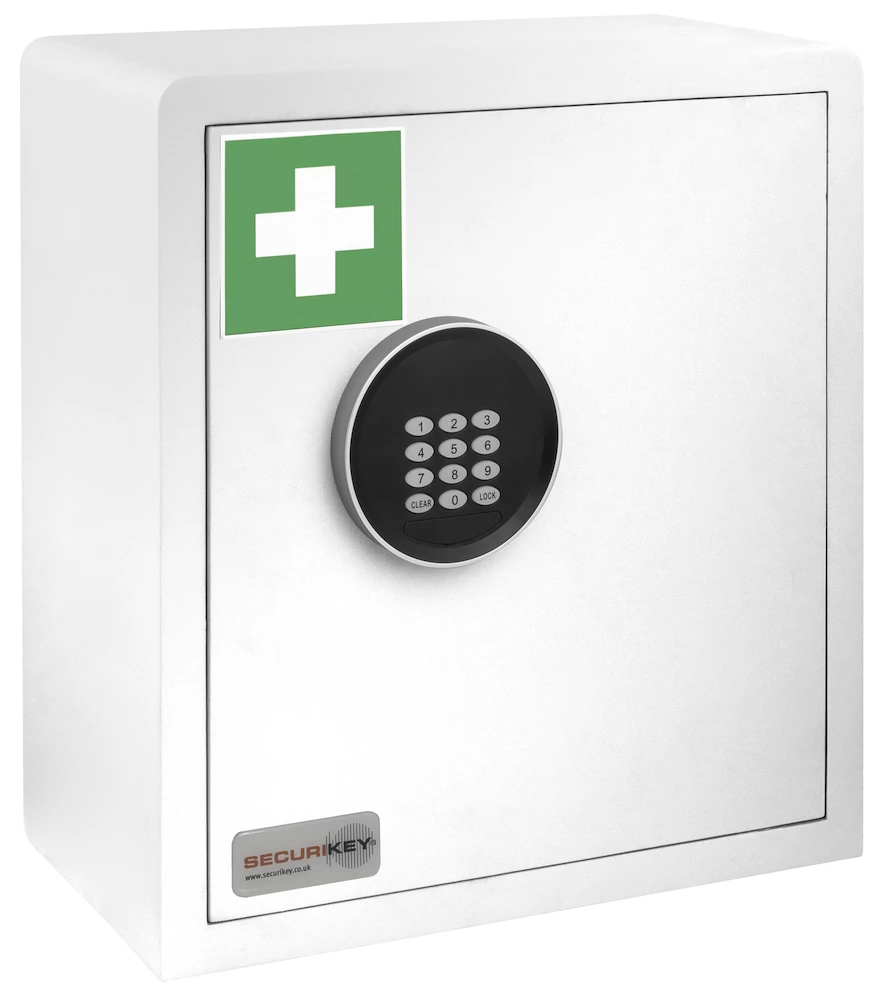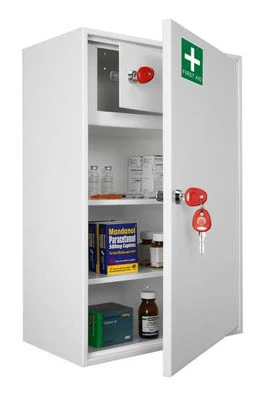Industrial sites need medical storage that is secure, hygienic, and compliant. Moreover, your solution must fit real-world workflows in warehouses, factories, food plants, and onsite clinics. This guide explains how UK guidance shapes your choice: HSE First-Aid Regulations, BS 8599-1 kit guidance, BS 2881 medicine-cupboard security, COSHH separation, and cleanroom considerations. Then it maps specifications to typical industrial settings with clear examples, internal resources, and authoritative external links.

Industrial medical vs COSHH vs medicines storage
First, clarify terms. An industrial medical (first-aid) cabinet holds first-aid kits and related supplies. A medicine cupboard stores medicines under clinical or occupational health supervision and should meet BS 2881 performance levels. By contrast, a COSHH cabinet stores hazardous substances and must stay separate from medical storage. Consequently, you should plan three distinct storage types across most large sites: first-aid, medicines (if used), and chemicals.
- HSE: What to put in a first-aid kit (needs assessment)
- BS 2881 overview (medicine cupboards)
- COSHH: control and segregation basics
Standards & duties (fast reference)
- HSE First-Aid Regulations (L74): employers must provide suitable first-aid equipment, facilities, and trained people. Start with a needs assessment and then select kit sizes and cabinet capacity. See HSE L74.
- BS 8599-1: sets content specifications for workplace first-aid kits (small, medium, large, travel, personal issue, and critical injury packs). Therefore, cabinet shelves should suit chosen kit sizes. See BSI BS 8599-1.
- BS 2881: defines performance levels for cupboards that store medicines. Level 1 is the common baseline in clinical/occupational health rooms. See the NHS summary here.
- COSHH: keep chemical storage separate using designated COSHH cabinets and a segregation plan. Guidance starts here.
- Warehousing (HSG76): site layout and emergency access affect cabinet siting; consult HSG76.
- Cleanrooms (ISO 14644): some pharma and high-care environments may require stainless, sealed edges, and easy-clean geometry; see ISO 14644-1.
When to choose each type of cabinet
| Setting | Best-fit cabinet | Why it fits | Key standards |
|---|---|---|---|
| Warehouse & logistics | Wall-mounted first-aid cabinet; IP-rated where dusty | Fast access near risk hotspots; clear signage and lighting | HSE L74; HSG76; BS 8599-1 |
| General manufacturing | Powder-coated steel first-aid cabinet with adjustable shelves | Durable finish; shelves sized to kit boxes; keypad lock for shared teams | HSE L74; BS 8599-1 |
| Food processing (washdown) | Stainless/SGL cabinet; sealed edges; IP65 where appropriate | Hygienic geometry and corrosion resistance; HACCP-friendly | HSE hygiene; local HACCP |
| Onsite medical/OH room | BS 2881 medicines cupboard; optional internal lockbox | Controlled storage of medicines; audited access | BS 2881; HBN 14-02 (NHS) |
| Pharma/cleanroom | Stainless 304/316 cabinet; concealed fixings | Low particle-shedding; smooth wipe-down | ISO 14644-1; site GMP |
Sizing the cabinet to your risk and headcount
Right-size the cabinet by mapping headcount, shift pattern, and injury profile to BS 8599-1 kit sizes. Next, specify shelf spacing for boxed kits, dressings, eyewash, and an AED bracket if required. Finally, allow extra volume for replenishment stock so kit rotation remains straightforward.
- Low-risk offices: small or medium kits per team; compact cabinets near egress routes.
- Mixed risk factories: medium and large kits per cell; mid-height shelves for bulky items.
- High-risk lines: large kits and critical injury packs; clear labelling for rapid grab-and-go.
Security & access control
Access must be quick, yet controlled. Therefore, choose a lock system that suits your supervision model. For shared industrial areas, keypads avoid misplaced keys. For clinics, RFID creates an audit trail. Where medicines are stored, specify a BS 2881 cupboard and document key custody or credential control.
- Keyed: simple, low cost; however, keys need strict custody and logs.
- Keypad: removes keys; rotate codes by shift; maintain an override plan.
- RFID: cards, fobs, or staff badges; enables audit and integration.
Materials & hygiene: pick for the environment
Cabinet materials should match the cleaning regime. Powder-coated steel suits most dry industrial rooms. Stainless or SGL fronts suit wet or washdown zones. In cleanrooms, reduce edges and exposed fixings. Likewise, prefer flat faces, rounded corners, and wipe-friendly pulls. As a result, daily cleaning takes less time and gives more consistent results.
Installation & siting checklist
- Mounting height: fix shelves so the heaviest kit sits between knee and chest height.
- Substrate: confirm blockwork or pattress; select anchors for specified loads.
- Routes: provide clear approach; keep a 1 m cleaning strip where possible.
- Signage & lighting: add conspicuous first-aid signs and adequate illumination.
- IP rating: consider IP54–IP65 in dusty or wet areas after risk assessment.
Audits, replenishment, and records
Even the best cabinet fails without a habit. Therefore, create a monthly audit with expiry checks and an incident-feedback loop. Record replacements, update contents to match actual injuries, and retrain teams annually. Where you hold medicines, also record access events and key custody.
Do not mix: COSHH vs medical storage
Never store chemicals with first-aid supplies or medicines. Instead, use COSHH cabinets with a segregation plan and spill control. Keep medical storage in separate rooms or zones with distinct signage and SOPs. Consequently, you reduce cross-contamination risks and improve audits.
Internal resources (from your blogs)
- Choosing the Right Medical Cabinet (Secure Storage Blog) — features KFAK cabinet options and practical selection notes.
- Hospital lockers: how to choose — helpful for hygiene geometry and lock selection.
- Industrial Cabinets & Cupboards overview — positions medical storage within wider industrial cabinetry.
- Medication security made simple — useful access-control ideas to adapt for OH rooms.
- Ultimate guide to locker solutions — background on lock types, sizes, and use-cases.
Authoritative external guidance
- HSE First aid at work (L74): employer duties and needs assessment
- HSE: What to put in a first-aid kit
- BSI BS 8599-1 contents overview
- BS 2881 (medicine cupboards) summary
- HSG76: Warehousing & storage
- COSHH: control of hazardous substances
- ISO 14644-1 cleanroom classification
Copy-and-paste specification text
Objective: Supply and install industrial medical storage for [site/zone].
Standards: First-aid provision per HSE L74; kit selection per BS 8599-1. Where medicines are stored, cupboards shall meet BS 2881 Level 1 minimum. Chemicals stored separately in COSHH cabinets per site COSHH assessment.
Construction: Powder-coated steel (or stainless/SGL for wet/high-care areas); flat faces; rounded corners; minimal exposed fixings.
Access: [Keyed/Keypad/RFID] with documented custody, code rotation, or credential audit; override plan for emergencies.
Interiors: Adjustable shelves sized for small/medium/large BS 8599-1 kits; dedicated space for eyewash/AED bracket where specified.
Installation: Anchors to verified substrate; mounting height to place heaviest items between knee and chest height; clear 1 m cleaning strip.
Documentation: As-installed drawing; lock codes/keys register; monthly audit checklist; replenishment log template.
FAQs
Is BS 8599-1 mandatory? Not by law; however, HSE recommends using a needs assessment and many employers reference BS 8599-1 to standardise contents and stocking.
When do I need a BS 2881 cupboard? Use BS 2881 when you store medicines in an occupational health room or clinic, or where clinical supervision applies.
Can chemicals sit in the same cabinet as first-aid supplies? No. Store chemicals in COSHH cabinets with segregation and spill control, away from medical storage.
SEO package
- SEO Title:
- Slug:
- Meta Description:
- Focused Key Phrase:
- Keyphrase Variants: industrial medicine cupboards; BS 2881 medicine cabinet; BS 8599 first-aid cabinet; warehouse first-aid room; stainless medical cabinet; IP-rated medical cabinet; COSHH vs medical storage; cleanroom medical cabinet.
Suggested images (paste real URLs and keep ALT text)
<img src="IMAGE_URL" alt="Wall-mounted industrial first-aid cabinet with BS 8599-1 kits in a warehouse corridor"><img src="IMAGE_URL" alt="Stainless medical cabinet with sealed edges for food factory washdown area"><img src="IMAGE_URL" alt="BS 2881 Level 1 medicines cupboard in an onsite occupational health room"><img src="IMAGE_URL" alt="RFID keypad on an industrial medical cabinet providing audited access"><img src="IMAGE_URL" alt="Cleanroom-compatible stainless medical cabinet with concealed fixings">
